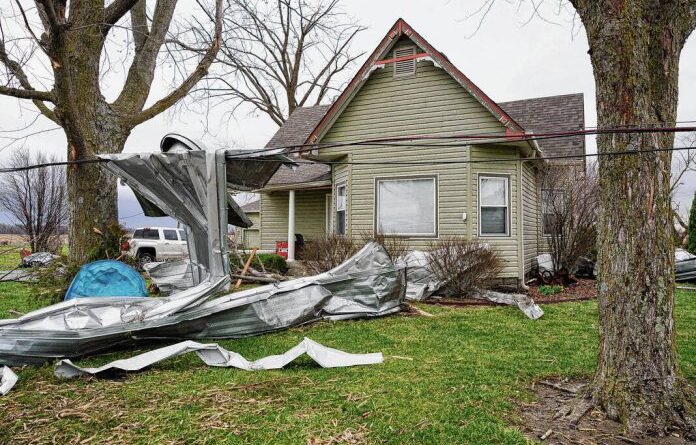SBA offers relief to businesses, residents impacted by tornado

Mike Wolanin | The Republic A view of the damage to Mark and Heather Baker’s home from a suspected tornado in Columbus, Ind., Thursday, March 20, 2025.
The U.S. Small Business Administration (SBA) announced Friday the availability of low-interest federal disaster loans for small businesses, private nonprofits and residents in Bartholomew County and other Indiana communities affected by severe storms and tornadoes occurring March 19.
The SBA issued a disaster declaration in response to a request received from Gov. Mike Braun on April 10. The disaster declaration covers the primary counties of Bartholomew and Lake, which are eligible for both physical damage loans and Economic Injury Disaster Loans (EIDLs). The declaration also covers the adjacent counties of Brown, Decatur, Jackson, Jasper, Jennings, Johnson, Newton, Porter and Shelby counties in Indiana, as well as Cook, Kankakee and Will counties in Illinois.
The Bartholomew County Disaster Loan Outreach Center (DLOC) will be located at United Way of Bartholomew County, 1531 13th St., Columbus. It will be open beginning Monday from 9 a.m. to 5 p.m. After that, regular operating hours will be 8 a.m. to 5 p.m. Mondays through Fridays, and 10 a.m. to 2 p.m. on Saturdays.
The outreach center will close at 2 p.m. May 10.
An EF-2 tornado touched down in Bartholomew County on March 19 during severe thunderstorms and was on the ground for 13.55 miles, “a pretty good length of time” with a maximum width of 350 yards, according to Bartholomew County Emergency Management.
The National Weather Service said the tornado started at County Road 625S at County Road 200W and then moved east and northeast eventually to Burnsville, where the damage became more sporadic and the system weakened. Most of the damage was listed as an EF-0 or EF-1 tornado with short times of EF-2, she said.
Both of the locations identified as being EF-2 had well-built metal farm buildings that had collapsed walls and roofs, and debris at both locations went aloft and was distributed from a quarter to half mile to the north and northeast.
Much of the damage concentrated on family farms in the tornado’s path, scattering empty grain bins into farm fields and taking down Duke Energy poles and lines and an AES Power transmission tower.
Small businesses and private nonprofits are eligible to apply for business physical disaster loans and may borrow up to $2 million to repair or replace disaster-damaged or destroyed real estate, machinery and equipment, inventory, and other business assets.
Homeowners and renters are eligible to apply for home and personal property loans and may borrow up to $100,000 to replace or repair personal property, such as clothing, furniture, cars and appliances. Homeowners may apply for up to $500,000 to replace or repair their primary residence.
Applicants may also be eligible for a loan increase of up to 20% of their physical damage, as verified by the SBA, for mitigation purposes. Eligible mitigation improvements include strengthening structures to protect against high wind damage, upgrading to wind rated garage doors, and installing a safe room or storm shelter to help protect property and occupants from future damage.
“One distinct advantage of SBA’s disaster loan program is the opportunity to fund upgrades reducing the risk of future storm damage,” said Chris Stallings, associate administrator of the Office of Disaster Recovery and Resilience at the SBA, in a statement. “I encourage businesses and homeowners to work with contractors and mitigation professionals to improve their storm readiness while taking advantage of SBA’s mitigation loans.”
SBA’s EIDL program is available to eligible small businesses, small agricultural cooperatives, nurseries, and PNPs with financial losses directly related to this disaster. The SBA is unable to provide disaster loans to agricultural producers, farmers or ranchers, except for aquaculture enterprises.
EIDLs are for working capital needs caused by the disaster and are available even if the business did not suffer any physical damage. They may be used to pay fixed debts, payroll, accounts payable and other bills not paid due to the disaster.
Interest rates are as low as 4% for small businesses, 3.625% for PNPs, and 2.75% for homeowners and renters, with terms up to 30 years. Interest does not begin to accrue, and payments are not due until 12 months from the date of the first loan disbursement. The SBA sets loan amounts and terms based on each applicant’s financial condition.
Beginning Monday, SBA customer service representatives will be on hand at the Disaster Loan Outreach Centers in Bartholomew and Lake counties to answer questions about SBA’s disaster loan program, explain the application process and help individuals complete their application. Walk-ins are accepted, but you can schedule an in-person appointment in advance at appointment.sba.gov.

